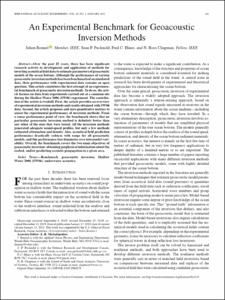| dc.contributor.author | Bonnel, Julien | |
| dc.contributor.author | Pecknold, Sean P. | |
| dc.contributor.author | Hines, Paul C. | |
| dc.contributor.author | Chapman, N. Ross | |
| dc.date.accessioned | 2022-12-09T18:14:05Z | |
| dc.date.available | 2022-12-09T18:14:05Z | |
| dc.date.issued | 2021 | |
| dc.identifier.citation | Bonnel, J., Pecknold, S.P., Hines, P.C. and Chapman, N.R. (2021) An Experimental Benchmark for Geoacoustic Inversion Methods. IEEE Journal of Oceanic Engineering, 46, pp. 261-282. DOI:10.1109/JOE.2019.2960879 | en_US |
| dc.identifier.uri | https://repository.oceanbestpractices.org/handle/11329/2105 | |
| dc.description.abstract | Over the past 25 years, there has been significant
research activity in development and application of methods for
inverting acoustical field data to estimate parameters of geoacoustic
models of the ocean bottom. Although the performance of various
geoacoustic inversionmethods has been benchmarked on simulated
data, their performance with experimental data remains an open
question. This article constitutes the first attempt of an experimental
benchmark of geoacoustic inversionmethods. To do so, the article
focuses on data from experiments carried out at a common site
during the ShallowWater 2006 (SW06) experiment. The contribution
of the article is twofold. First, the article provides an overview
of experimental inversionmethods and results obtained with SW06
data. Second, the article proposes and uses quantitative metrics to
assess the experimental performance of inversion methods. From
a sonar performance point of view, the benchmark shows that no
particular geoacoustic inversion method is definitely better than
any other of the ones that were tested. All the inversion methods
generated adequate sound-speed profiles, but only a few methods
estimated attenuation and density. Also, acoustical field prediction
performance drastically reduces with range for all geoacoustic
models, and this performance loss dominates over intermodel variability.
Overall, the benchmark covers the two main objectives of
geoacoustic inversion: obtaining geophysical information about the
seabed, and/or predicting acoustic propagation in a given area. | en_US |
| dc.language.iso | en | en_US |
| dc.rights | Attribution 4.0 International | * |
| dc.rights.uri | http://creativecommons.org/licenses/by/4.0/ | * |
| dc.subject.other | Geoacoutstic inversion | en_US |
| dc.subject.other | Shallow water acoustics | en_US |
| dc.subject.other | Underwater acoustics | en_US |
| dc.subject.other | Benchmark | en_US |
| dc.title | An Experimental Benchmark for Geoacoustic Inversion Methods. | en_US |
| dc.type | Journal Contribution | en_US |
| dc.description.refereed | Refereed | en_US |
| dc.format.pagerange | pp.261-282 | en_US |
| dc.identifier.doi | 10.1109/JOE.2019.2960879 | |
| dc.subject.parameterDiscipline | Field geophysics | en_US |
| dc.bibliographicCitation.title | IEEE Journal of Oceanic Engineering | en_US |
| dc.bibliographicCitation.volume | 46 | en_US |
| dc.bibliographicCitation.issue | 1 | en_US |
| dc.description.sdg | 14.a | en_US |
| dc.description.maturitylevel | Mature | en_US |
| dc.description.adoption | Validated (tested by third parties) | en_US |
| dc.description.adoption | International | en_US |
| dc.description.methodologyType | Reports with methodological relevance | en_US |
| obps.contact.contactname | Julien Bonnel | |
| obps.contact.contactemail | jbonnel@whoi.edu | |
| obps.resourceurl.publisher | https://ieeexplore.ieee.org/abstract/document/8962151 | |
 Repository of community practices in Ocean Research, Applications and Data/Information Management
Repository of community practices in Ocean Research, Applications and Data/Information Management

